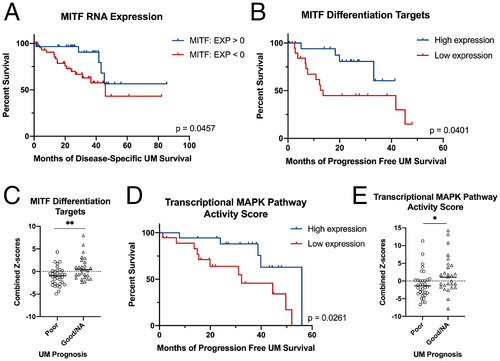
Decreased expression of MITF target genes and decreased MAPK transcriptional activity correlate with poor UM patient survival. RNA sequencing of primary human UM (n = 80 patients) and the corresponding survival data were obtained from TCGA PanCancer Atlas database. (A) Patients with relatively lower MITF RNA expression (z score < 0; n = 49) have significantly decreased (P = 0.0457, determined by log-rank test) disease-free survival compared to patients with relatively higher MITF RNA expression (z score > 0; n = 31). (B) Z scores for the MITF differentiation target genes DCT, TYR, TYRP1, and SILV were calculated and summed for each UM tumor, and patients in the lower quartile (n = 20) were found to have significantly decreased (P = 0.04, determined by log-rank test) progression-free survival compared to patients in the upper quartile (n = 20). (C) UM patients were binned by “poor prognosis” (those deceased or with progression of the disease [n = 34]) versus “good/NA prognosis” (those last reported as living without progression for at least 2 y [n = 27]). The poor prognosis cohort showed significantly lower combined z scores for the four MITF differentiation targets (P = 0.0041, determined by Student’s unpaired t test; line denotes median). (D) Z scores for genes in the transcriptional MAPK activity gene set were calculated and summed. Patients in the lower quartile (n = 20) showed significantly decreased (P = 0.0261, determined by log-rank test) progression-free survival compared to patients in the upper quartile (n = 20). (E) UM patients with poor prognosis (binned as described in C) have a significantly lower transcriptional MAPK pathway activity combined z scores (P = 0.0218, determined by Student’s unpaired t test; line denotes median) than the good/NA prognosis cohort.
|